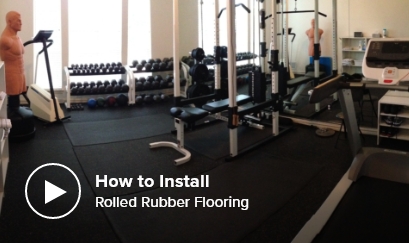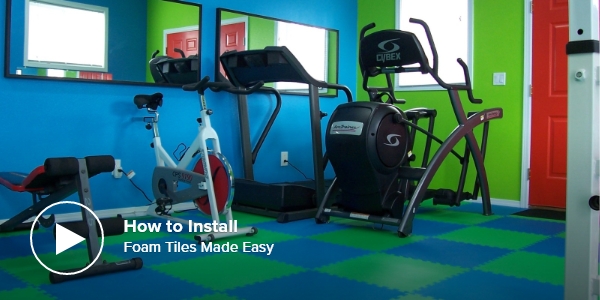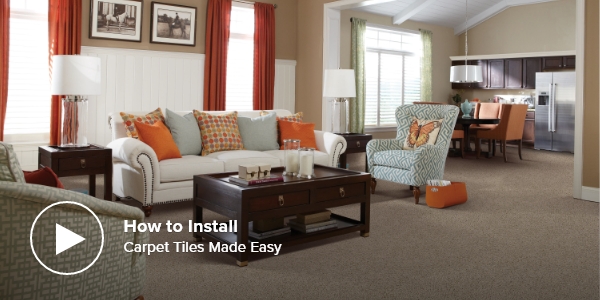Upgrade Your Gym: 2024 Best Home Gym Flooring Options
You’re finally ready to build your home gym, and now can finally get in your workout even when you can’t make it to the local gym. But wait! There’s one critical piece that is often forgotten – your floor!
The floor is one of the most essential pieces in your home gym. It’s important to choose a floor that can protect both your joints and your subfloor from the demands of your fitness routine.
Start building your gym with our top options for the best home gym flooring ideas. Use this guide to choose from rubber, foam, carpet, turf, or vinyl, and find the best option for you.
The floor is one of the most essential pieces in your home gym. It’s important to choose a floor that can protect both your joints and your subfloor from the demands of your fitness routine.
Start building your gym with our top options for the best home gym flooring ideas. Use this guide to choose from rubber, foam, carpet, turf, or vinyl, and find the best option for you.
Rubber Gym Flooring
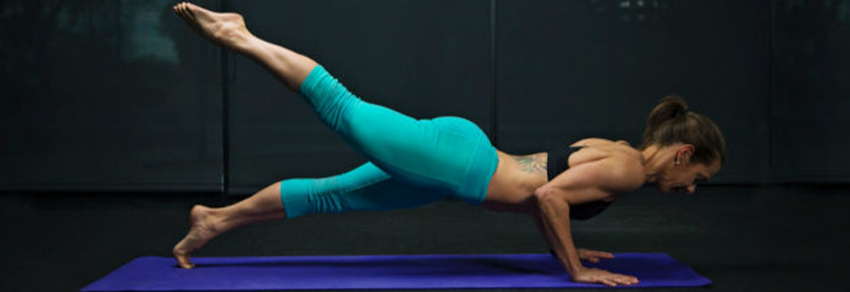
Rubber is the premier garage gym flooring option. Walk into just about any gym or fitness studio and you’re certain to see they use rubber flooring.
While you have many choices when it comes to home gym flooring ideas, rubber flooring is the best option. They are most versatile, making them perfect for any workout. Also, it protects your subfloor from the impact of heavy weights while you lift.
Rubber gym flooring is available in tiles, rolls, and mats. Each option has a wide range of thickness options to suit your needs.
To make your space look sharp, you can choose between a wide variety of color and fleck options.
Let’s take a look at your options.
While you have many choices when it comes to home gym flooring ideas, rubber flooring is the best option. They are most versatile, making them perfect for any workout. Also, it protects your subfloor from the impact of heavy weights while you lift.
Rubber gym flooring is available in tiles, rolls, and mats. Each option has a wide range of thickness options to suit your needs.
To make your space look sharp, you can choose between a wide variety of color and fleck options.
Let’s take a look at your options.
Rubber Gym Floor Tiles

Rubber tiles are the most popular home gym flooring option on the market. They are durable, affordable, and known for their easy, DIY, interlocking installation.
Homeowners love that installing rubber tiles is just like putting together a giant puzzle. Each tile contains interlocking edges that fit together in seconds.
Choose from multiple thickness options to find the right choice to protect your subfloor. If you plan to drop 100 lb. dumbbells or heavier ones, you’ll want to choose a thicker rubber tile.
Homeowners love that installing rubber tiles is just like putting together a giant puzzle. Each tile contains interlocking edges that fit together in seconds.
Choose from multiple thickness options to find the right choice to protect your subfloor. If you plan to drop 100 lb. dumbbells or heavier ones, you’ll want to choose a thicker rubber tile.
Customer Favorite Rubber Gym Tiles
Rubber Gym Flooring Rolls
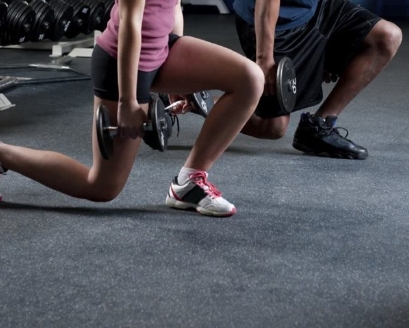
Rubber rolls are known for their seamless appearance. When installed correctly, it is nearly impossible to see where one roll ends and another begins.
Rubber gym flooring rolls come in a variety of different thickness options to suit your needs. You can even purchase high-impact rubber rolls that are specially designed to keep your joints safe during high-impact, plyometric movements.
Rubber gym flooring rolls come in a variety of different thickness options to suit your needs. You can even purchase high-impact rubber rolls that are specially designed to keep your joints safe during high-impact, plyometric movements.
Customer Favorite Rubber Rolls
Rubber Gym Floor Mats

Sometimes it’s more convenient to have a rubber mat to provide you with the right amount of durability, density, and portability for your home gym. They’re great if you just need to cover a small area, such as a weight training station, underneath your treadmill, or just a small space to do your ab work.
You can choose anything from thin 1/4” gym mats for bodyweight exercises up to 1/2″ Mega Mats, which are for heavy weightlifters and high-impact workouts.
You can choose anything from thin 1/4” gym mats for bodyweight exercises up to 1/2″ Mega Mats, which are for heavy weightlifters and high-impact workouts.
Customer Favorite Gym Rubber Floor Mats
Pros of Rubber Flooring
- Easy to install: Whether you choose tiles, rolls, or exercise mats, you can install rubber flooring in your home gym without any professional help. Just make sure you have some friends to help if you choose rubber rolls because they can get pretty heavy.
- Ultra-durable: Rubber flooring is perhaps the most durable home gym flooring option available.
- Best shock absorption: For tough workouts and heavy weights, rubber gym flooring will absorb the shock, keeping your joints and subfloor safe and sound.
- Easy to clean: Just vacuum or use a damp mop when necessary.
- Antimicrobial: That’s a fancy way to say you won’t see weird things growing on your floor.
- Water-resistant: Sweat your heart out and create your home gym on any level, including your basement. Rubber isn’t particular.
- Excellent sound absorption: Drop those weights and run miles on the treadmill – rubber will help absorb the sound.
Cons of Rubber Gym Flooring
- Weight: With all that durability comes a pretty bulky floor that weighs quite a bit. If you choose rubber rolls, you’ll want to enlist the help of friends to help with installation.
- Little temperature insulation: Rubber is a bad insulator against temperature transmission. When you use rubber on cold basement subfloors, the rubber will still feel cold to the touch. However, rubber works well over heated flooring systems.
- Price: Some rubber home gym flooring options do get pretty pricey. Although it may not always be the cheapest option, it does typically provide the best value.
- Smell: New rubber flooring sometimes comes with a distinct rubber odor. Fortunately, you can address this by mopping the flooring with a mix of soap and water a few times and keeping the area well-ventilated.
Rubber Gym Flooring Installation
Rubber gym flooring is super easy to install on your own or with a little help from friends. We have a few options when it comes to installation methods for you!
- Loose lay home gym flooring: If you are loose-laying your rubber flooring, once you lay the flooring down, you’re done. Most of the time, the rubber is heavy enough to naturally stay in place with no extra adhesive necessary. If you loose lay your gym flooring, you can easily pick it up and move it at any time.
- Double-sided tape: For more intense conditions, consider using double-sided carpet tape around the perimeter of your floor. This is extremely easy and you will still be able to transport your rubber gym flooring if you change locations.
- Glue-down: In extreme conditions, some CrossFit and high-intensity athletes prefer to fully glue down their rubber gym flooring. This is for rubber gym flooring rolls only and will ensure no movement and no curling up at the edges. However, once the rolls are glued, they cannot go with you if you move locations.
Foam Gym Flooring
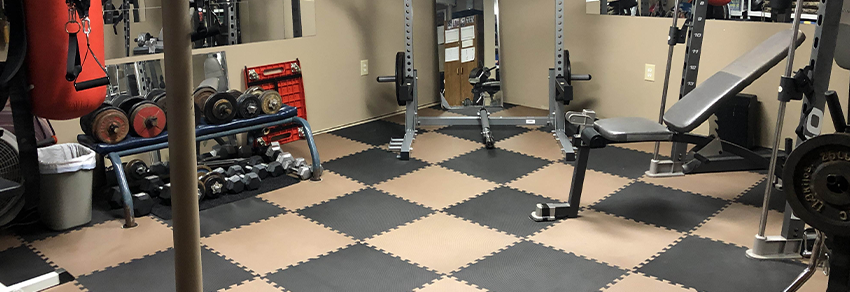
For the lightest and most affordable home gym flooring, soft foam tiles are the winner. With tons of fun colors and beautiful wood looks to choose from, you can easily jazz up your space with this popular home gym flooring option.
Foam is great for bodyweight exercises and light workouts. Installation is truly a DIY dream. Just lay your foam down and, interlock the tiles. Foam gym flooring in minutes.
While it can’t hold up to intense dumbbells and Olympic lifting the way rubber can, it is a great option for any starter home gym.
Foam is great for bodyweight exercises and light workouts. Installation is truly a DIY dream. Just lay your foam down and, interlock the tiles. Foam gym flooring in minutes.
While it can’t hold up to intense dumbbells and Olympic lifting the way rubber can, it is a great option for any starter home gym.
Pros of Foam Gym Flooring
- Price: Foam is the least expensive home gym flooring on the market.
- Lots of cushion: This is ideal for athletes who do a lot of floor work such as sit-ups and stretching.
- Easy to clean: If your tiles get dirty, just wipe them down with a damp cloth and they’ll look good as new.
- Safe for kids: Parents love that foam tiles also provide a safe surface for kids, absorbing the shock of those learning-to-walk tumbles. Go ahead and make the most out of your space, using it as a home gym and play area.
- Lightweight: Foam gym flooring is super light, which makes it super portable.
- Easy to install: Lock the tiles together on the floor and you’re done.
- Color and look options: Many home users also choose foam tiles since they can mix and match colors to form custom designs like checkerboard or border patterns.
Cons of Foam Gym Flooring
- Not recommended for heavy weights and equipment: Unfortunately, it’s easy to compress foam tiles under heavy-weight equipment.
- No sharp objects: You can easily puncture, cut, or slice foam with sharp objects. That’s why we do not recommend walking on any type of foam flooring with high-heeled shoes.
Foam Gym Flooring Installation
Foam gym flooring is super easy to install on your own in just minutes. You have a few options when it comes to installation methods.
- Loose lay home gym flooring: With this method, you can lay it down and easily pick it up and move it at any time.
- Double-sided tape: Since foam is lightweight, it can require a little security to keep it in place during your workouts. For a more stable environment, consider using double-sided carpet tape around the perimeter of your floor. This is extremely easy and you will still be able to transport your foam gym flooring if you change locations.
Customer Favorite Foam Gym Flooring
Gym Carpet Tiles
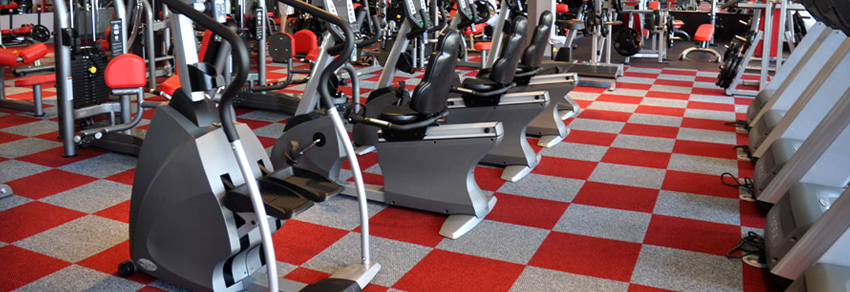
Carpet is the most popular floor covering option in America. All-purpose, relatively inexpensive, comfortable to the touch, and fairly easy to clean and maintain. Carpet is an excellent home gym flooring solution!
For home gym flooring, we recommend a short, thin, low-pile carpet.
Low-pile is usually much more durable than fluffy shag or even soft Berber-style carpets often found in homes. Commercial-grade carpet also works very well for home gyms due to its tight-knit loops.
Interlocking carpet tiles are also often used for exercise since they’re so DIY-friendly.
For home gym flooring, we recommend a short, thin, low-pile carpet.
Low-pile is usually much more durable than fluffy shag or even soft Berber-style carpets often found in homes. Commercial-grade carpet also works very well for home gyms due to its tight-knit loops.
Interlocking carpet tiles are also often used for exercise since they’re so DIY-friendly.
Pros of Carpet Tile Gym Flooring
- Durable: Carpet tiles are extremely durable gym flooring. They can hold up to many years of abuse before you need to replace them.
- Approachable: Carpet is also a favorite gym flooring option since the average person completely understands and already knows how to take care of it.
- A touch of softness: Just like foam, carpet can provide a multi-use space perfect for workouts and family time.
- Color options: Carpet tiles are available in a wide array of colors so you can easily choose your perfect look.
Cons of Carpet Tile Gym Flooring
- Trickier installation: While interlocking carpet tiles are easy to install, home gym carpet tiles that don’t interlock need to be installed by a professional.
- Water retention: There are some water-resistant carpet gym flooring options. However, others can hold moisture and require professional cleaning every few years.
- Less subfloor protection: While rubber flooring is specifically designed as a protective home gym floor covering, carpet is not made for this and you will need a layer of underlayment to prevent cracks in your subfloor from the stress of heavy weights.
Carpet Tile Gym Flooring Installation
Carpet is hit or miss when it comes to ease of installation. Interlocking tile and loose lay tile options can be done in a day, while broadloom carpets require a professional. Here are a few installation options.
- Loose lay home gym flooring: If you are using interlocking tiles and/or loose laying your home gym flooring after you lay it down, you are done! If you loose lay your gym flooring, you can easily pick it up and move it at any time.
- Double-sided tape: For more intense conditions, consider using double-sided carpet tape around the perimeter of your floor. This is extremely easy and you will still be able to transport your gym flooring if you change locations.
- Glue-down: In extreme conditions, some CrossFit and high-intensity athletes prefer to fully glue down their carpet gym flooring.
Customer Favorite Gym Carpet Tiles
Conclusion
Are you pumped to build your own home gym? With the right flooring that meets your needs, you can start your fitness journey on the right foot. Don’t let the inspiration pass you by. Order some free samples of your favorite flooring today!



